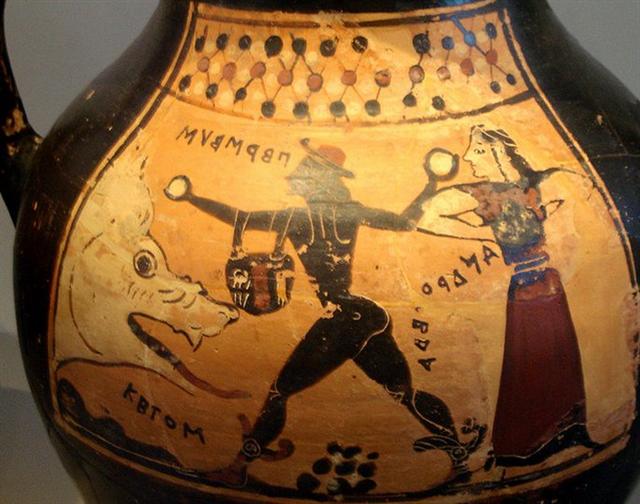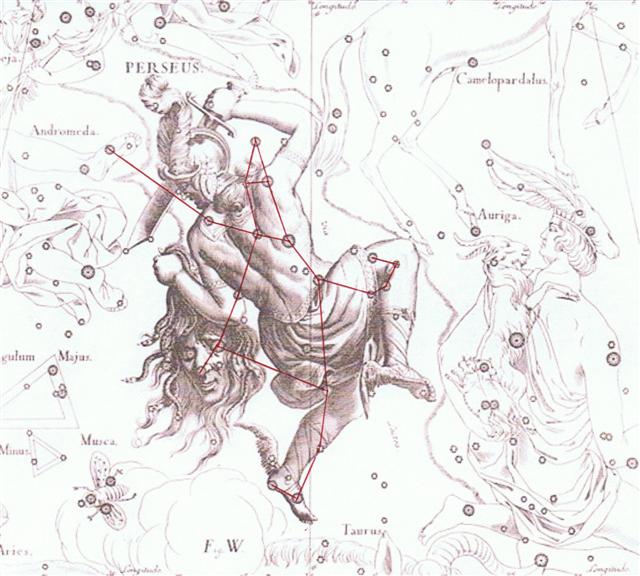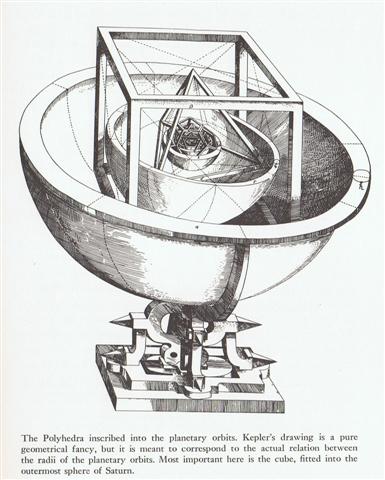From the new perspective we can once again look at line Ca14. The discovery of Uranus ought to have been possible to accomodate in the old cosmic system, but the discovery of Neptune must have threatened the whole structure. It should have been comparable to the discovery of the Americas or of extraterrestial life. It was a planet which the ancients could not have discovered for it was outside the reach of the human senses. If there was a time to reassess the ancient cosmos it was now. Perhaps glyph 378 was meant to represent Saturn. The god of time had a weapon which was halfway between a spear and a sickle:
... In the Olympian creation myth, as Hesiod tells it in the Theogony, Uranus came every night to cover the earth and mate with Gaia, but he hated the children she bore him. Hesiod named their first six sons and six daughters the Titans, the three one-hundred-armed giants the Hekatonkheires, and the one-eyed giants the Cyclopes. Uranus imprisoned Gaia's youngest children in Tartarus, deep within Earth, where they caused pain to Gaia. She shaped a great flint-bladed sickle and asked her sons to castrate Uranus. Only Cronus, youngest and most ambitious of the Titans, was willing: he ambushed his father and castrated him, casting the severed testicles into the sea. For this fearful deed, Uranus called his sons Titanes Theoi, or 'Straining Gods' ... The synodic cycle of Saturn is 378 days and that of Uranus 370 days. The number of glyphs on the C tablet is 2 * 370 = 740. The more far out a planet is from Earth the less difference should there be between its synodic cycle and the solar year. If a star did not move from year to year it could not be a planet.
Our conventional sign for Saturn could hardly have been adequate for the rongorongo writers. They would rather have a sign which was similar to that of Mars (who 'killed' the winter and not the old year). The position of Saturn should be late in the cycle instead of early. In other words, the rongorongo glyph for Saturn ought to be similar to that of Uranus (excepting the dot in its center which could not be drawn):
There are 2 exactly alike Saturn glyphs in the text to be considered, also the one close to the end of line Ca13 in glyph position 362:
Here (4 days after the Gregorian π day) Metoro told Bishop Jaussen to count (hia), and 378 - 362 = 16.
The Queen who is falling out of her chair in April 2 is Cassiopeia and her star Cih is γ:
I think her compressed (opposite to opening up) posture resembles the Phoenician gimel. "γ ... in Cassiopeia's girdle, was the Chinese Tsih, a Whip." (Allen) Another way to look at her is to see the outline of M upside down: ... Cassiopeia, or Cassiope, more correctly Cassiepeia, although variously written, is one of the oldest and popularly best know of our constellations, and her throne, 'the shinie Casseioppeia's chair', of Spencer's Faerie Queen, is a familiar object to the most youthful observer. It is also known as the Celestial W when below the pole, and the Celestial M when above it ... Possibly the change from Σ to Μ on the Corinthian vase was meant as a sign alluding to Cassiopeia. Instead of her W indicating a position below the seat of the ruler at the pole (i.e. with the Queen dethroned) Perseus had managed to restore the situation, to reinstall the Queen ('recycled' as Andromeda):
Interesting is the fact that a similar vero glyph occurs in the G text at heliacal Algol (33 days later):
5 * 25 = 125 is a cube for Saturn:
| |||||||||||||||||||||||||||||||||||||||||||||||||||||||||||||||||||||||||||||||||||||||||||||||||||||||||||||||||||||||||||||||||||









